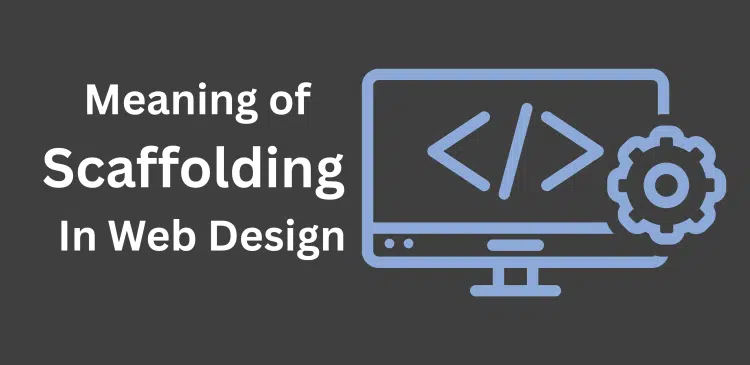What Does It Mean to Scaffolding Web Design?

Scaffolding serves as a strategic approach in the ever-evolving realm of website development, acting as a flexible concept that supports both beginners and experienced designers in creating adaptable, efficient, and impactful web designs. In web design, scaffolding refers to a method where a temporary structure is established to outline the intended design before finalizing the layout. This approach allows designers to visualize and refine their ideas effectively. This idea originates from the use of construction scaffolding, where an item is temporarily secured only to be taken down later once the building structure is established. In a similar vein, web design scaffolding offers a foundational framework that enables developers to build a clear, stable, and organized design.
Grasping the Basics
Scaffolding in web design can be simply explained as the process of establishing fundamental structures that serve as the foundation for building a website. This foundation plays a crucial role in managing files and directories, ensuring that the website can be easily accommodated and expanded in the future without complications or difficulties. An excellent illustration of a well-structured website features a directory layout that includes HTML, CSS, JS, and images in an organized manner. This approach enhances readability, simplifies the implementation of changes, and allows the organization to view programs in a well-structured format.
Elements of Scaffolding
- Directory Structure:A standout aspect of the scaffolding is its well-organized layout, which is crucial for managing subdirectories effectively. This involves organizing files into specific folders such as ‘assets’ for images and media files, ‘css’ for styles, ‘js’ for JavaScript, and ‘pages’ for HTML files. The divisions outlined above allow for changes to be made independently, giving developers the freedom to work on the project in their own way.
- Version Control:An essential aspect of scaffolding is the implementation of version control systems, with git being a prime example. Version control allows software developers to track changes made to specific files, collaborate by copying or accepting the contributions of their teammates, and revert files to previous states when necessary. It also establishes a foundation for the ongoing development of the entire website’s structures while effectively overseeing its evolution.
- Responsive Design Frameworks:Depending on the selection of HTML or CSS, another crucial aspect of scaffolding is the implementation of responsive design frameworks such as Bootstrap and Foundation. Frameworks provide a collection of components and a grid system that simplifies the process of replicating browser layouts, ensuring that a website is compatible with various browser sizes and devices. With the assistance of navigation and other comparable tools, developers can create a consistent experience across all platforms.
- Code Standards and Conventions:Following established standards when writing code is crucial for maintaining a clean and easily readable codebase. This includes various naming conventions and constructions like Semantic HTML, CSS, JavaScript, along with other related standards and procedures. This approach allows developers to sidestep potential issues while improving the product and makes it easier to implement revisions as needed.
- Modularity:One of the essential aspects of scaffolding is its modular nature; every component of scaffolding is designed to be modular. Developers can effortlessly build a collection of elements that, when put together, form the layout of the website. This approach allows for quick modifications, rather than having to alter every individual layout across the site. This enhances the design process criteria while also conserving time and reducing manpower efforts for any future modifications.
- Tools and Scripting:Incorporating tools and scripts into the development process represents an innovative approach to scaffolding. These tools are great for tasks like minifying CSS and JavaScript, optimizing images, and deploying your website on a server. By implementing these processes, developers can save time to focus on the creative aspects of web design, while the software handles the technical details.
Advantages of Scaffolding
Scaffolding proves to be a powerful tool in web design, offering a range of advantages. To begin with, it opens up new avenues for the website’s development and growth. Once the website is set up, integrating additional page structures becomes a straightforward process, allowing for seamless incorporation without disrupting the existing framework.
Additionally, scaffolding fosters improved collaboration among team members. This approach enhances the restructuring of symbolic functions, promoting improved rationality, organized code, a well-structured directory, and greater flexibility in collaboration among developers, designers, and content creators. Developers should prioritize adhering to best practices, including well-structured code and standardized coding methods, to ensure the website remains easy to maintain in the future.
Scaffolding contributes to enhancing the process of theory construction. A seemingly straightforward feature such as presetting the website’s layout and utilizing commonly accessed elements for the open-source responsive design framework can significantly reduce the time developers spend on both building and maintaining the website. The concept of scaffolding plays a crucial role in enhancing the quality of a website. By adhering to established guidelines in coding and design, one can create a website that is not only functional but also visually appealing and user-friendly.
Challenges and Considerations
Scaffolding offers numerous benefits; however, it also comes with certain drawbacks and challenges that warrant careful consideration. One significant hurdle is getting started, as considerable time might be invested in arranging the locations mentioned. Creating a highly effective scaffolding framework requires meeting essential criteria and engaging in meticulous planning. This process can take a considerable amount of time and might prove challenging for those who aren’t very familiar with the software. It’s crucial for developers to carefully evaluate and assess the tools that can enhance their projects and bolster their team’s capabilities.
Moreover, scaffolding requires ongoing renovation and reinforcement to adapt to new programs and processes as it evolves. The web technologies and their associated practices are constantly evolving. This evolution suggests that the scaffolding framework should be periodically reviewed to align with the current programs.
